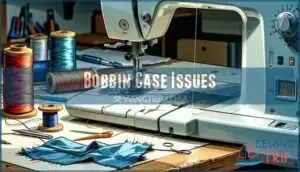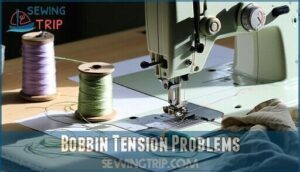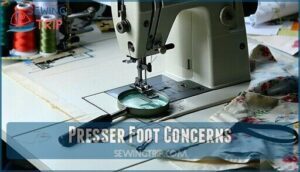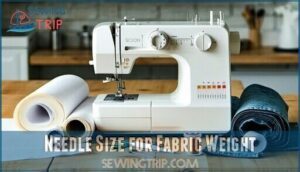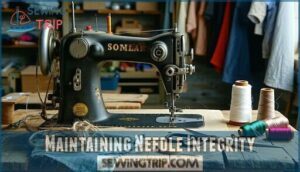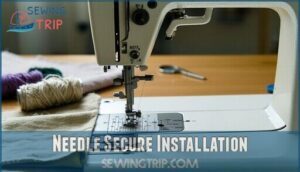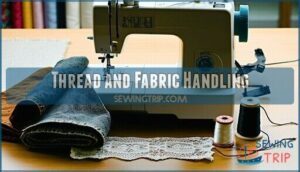This site is supported by our readers. We may earn a commission, at no cost to you, if you purchase through links.
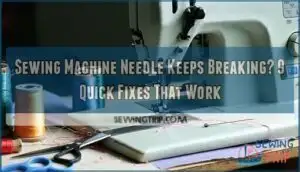 You’re frustrated because your sewing machine needle keeps breaking, but don’t worry, it’s a common issue.
You’re frustrated because your sewing machine needle keeps breaking, but don’t worry, it’s a common issue.
When your sewing machine needle keeps breaking, it’s often due to incorrect needle size, poor thread quality, or misaligned machine parts.
You can try adjusting the tension, checking the bobbin case, or switching to a heavier-duty needle.
By identifying the root cause, you’ll be back to sewing in no time.
Now, let’s get to the bottom of why your sewing machine needle keeps breaking and explore some simple fixes to get you sewing smoothly again.
Table Of Contents
- Key Takeaways
- Needle Breakage Causes
- Bobbin Case Issues
- Bobbin Tension Problems
- Damaged Needle Plate
- Presser Foot Concerns
- Choosing The Right Sewing Needle
- Needle Size for Fabric Weight
- Maintaining Needle Integrity
- Needle Secure Installation
- Thread and Fabric Handling
- Frequently Asked Questions (FAQs)
- Conclusion
Key Takeaways
- You’ll find that using the wrong needle size is a common reason your sewing machine needle keeps breaking, so it’s crucial to choose the right needle size for your fabric type and project demands.
- You should check your bobbin case and thread tension regularly, as misalignment or improper settings can cause needle breakage, and adjusting them can make a big difference in your sewing experience.
- You can prevent needle breakage by maintaining your machine, using the right needle type, and sewing carefully, and it’s also important to replace your needle every 8 hours or after a tricky project to ensure peak performance.
- You’ll need to inspect your needle plate and presser foot regularly, as damage or improper use can lead to needle breakage, and making adjustments or replacements as needed will help you sew smoothly and accurately.
Needle Breakage Causes
Breaking needles often stems from fundamental mismatches between your needle choice and project demands.
Using the wrong needle size creates unnecessary needle stress—too small for heavy fabrics causes bending, while oversized needles damage delicate materials.
Improper threading tangles around the needle shaft, creating fabric tension that snaps even quality needles.
Machine timing issues cause needles to strike the bobbin case at wrong intervals.
User error plays a major role: pulling fabric, sewing over pins, or forcing thick seams stresses the needle beyond its limits.
Dull or bent needles from previous projects compound these problems.
Regular needle replacement after eight hours prevents most needle breakage incidents before they start.
Proper thread tension settings are also essential to avoid unnecessary strain on the needle, ensuring proper threading and reducing user error with machine timing issues and improper threading.
Bobbin Case Issues
A misaligned bobbin case is a sneaky culprit behind many needle breaks. Think of it like a wonky wheel – it throws everything off!
Here’s how to keep yours in check:
- Bobbin Alignment: Make certain your bobbin case sits snugly, like a puzzle piece. Misalignment leads to needle strikes and breakage.
- Case Inspection: Regularly examine the bobbin case for damage. Nicks or burrs can catch threads, causing chaos.
- Bobbin Cleaning: Lint and debris buildup? Not on your watch! Clean regularly to prevent thread snags and keep your machine happy.
To prevent common issues, verifying thread tension problems that may affect your sewing machine’s performance is vital.
Keep your bobbin case happy, and your sewing machine needle will thank you!
Bobbin Tension Problems
You’re troubleshooting your sewing machine, and after checking the bobbin case, it’s time to examine the bobbin tension.
Proper bobbin adjustment is key to preventing thread knots and breakage.
Check your tension settings and adjust them as needed to guarantee smooth sewing.
If you’re experiencing thread breakage or needle breaking, it may be due to incorrect bobbin tension.
To resolve this, try tweaking the tension setting while guiding your fabric gently.
Remember, finding the right balance is important for sewing machine troubleshooting, and adjusting the bobbin threading can make a big difference in your sewing speed and overall experience.
Understanding bobbin tension issues is vital for maintaining your sewing machine’s performance and preventing common problems.
Damaged Needle Plate
You’ve checked bobbin tension, now inspect the needle plate for damage.
- Check for nicks
- Look for burrs
- Inspect for roughness
- Replace if necessary to prevent needle breaking and guarantee proper sewing alignment, consider plate replacement to avoid needle strike and broken needle issues.
Regular maintenance involves checking for needle plate problems to guarantee smooth sewing operation.
Presser Foot Concerns
When working with your sewing machine, using the right presser foot is essential. You’ll want to consult your machine’s manual to confirm you’re using the correct one for your project.
Adjusting the foot pressure is also key, as too much pressure can strain the needle, leading to breaking. On the other hand, too little pressure can cause skipped stitches.
Proper Presser Foot Alignment and Foot Adjustment are essential for Fabric Guidance and Sewing Accuracy. By getting this right, you’ll reduce needle pressure and thread tension, especially when working with varying fabric thickness.
Make the necessary adjustments to guide your material smoothly and achieve even stitches, saving you from the frustration of needle breaking. Understanding presser foot issues is vital to prevent common sewing problems and ensure a smooth sewing experience.
Choosing The Right Sewing Needle
You’re likely using the wrong sewing needle, which can lead to frequent breaking. Consider these key factors:
- Needle Materials
- Needle Types
- Needle Quality.
Choose the right needle type and size for your fabric density to prevent breakage.
With many sewing machine needles available, selecting the correct one can seem overwhelming, but it’s essential for a smooth sewing experience and to prevent needle breaking, ensuring you replace your needles regularly for peak performance.
Understanding the correct needle size selection is vital to achieve professional results and extend the life of your sewing machine.
Needle Size for Fabric Weight
You’ve chosen the right sewing needle, now consider fabric weight.
Lightweight fabrics need smaller needle sizes, like 8-11, while heavier ones require larger sizes, 16-18.
Match the needle gauge to your fabric’s thickness and density to prevent breaking, using the right needle size guarantees smooth sewing and prevents thread jams.
Proper needle selection involves understanding needle size standards to achieve superior results.
Maintaining Needle Integrity
If you’ve just squared away needle size and fabric weight, it’s time to think about needle integrity. At the point of preventing sewing machine needles breaking mid-project, a little Regular Inspection goes a long way.
Look for subtle bends, a dull point, or nicks—broken needles usually give you a few warning signs. Try a bit of Needle Lubrication to keep things gliding smoothly, especially with thick fabrics.
Keep that needle straight as an arrow with careful Needle Alignment, and don’t ignore machine calibration or proper needle care. Swap needles regularly—a tired needle is just asking for trouble.
These simple Preventive Measures and regular needle troubleshooting will keep your stitches—and your sanity—intact. Regular maintenance also involves understanding needle replacement guidelines to guarantee superior sewing performance.
Needle Secure Installation
Mastery at the sewing machine isn’t just about threading needles or picking pretty patterns—it starts with the nuts and bolts, like proper needle secure installation.
After keeping your needle clean and sharp, let’s talk needle alignment and getting things set up right for smooth stitching.
Make sure your new sewing machine needle is seated snugly in the shaft, pointing straight and true above the throat plate hole. It’s easy to rush, but even a tiny wobble can lead to breakage or skipped stitches.
Insert the needle all the way up, flat side facing the right direction. Now for screw tightening: crank down that needle clamp screw so there’s no room for movement.
Proper needle clamp installation is essential for preventing thread tension issues.
Here are three tips to remember:
- Double-check your needle placement before every project
- Don’t skimp on proper insertion or secure fitting
- Replace your needle after every tricky or prolonged stitch marathon
Thread and Fabric Handling
You’re almost a pro at securing your needle, now let’s tackle thread and fabric handling. To avoid needle breaks, balance thread tension and fabric guidance.
| Fabric Type | Needle Size |
|---|---|
| Delicate | Small |
| Thick | Large |
| Stretchy | Specialized |
| Heavy | Strong |
Adjust your sewing speed and material selection to protect your needle, preventing breaks and guaranteeing a smooth sewing experience with proper thread tension. Prior to sewing, consider pre-treating your fabrics to guarantee stability and prevent shrinkage.
Frequently Asked Questions (FAQs)
Why do sewing machine needles break?
You’ll find sewing machine needles break due to incorrect threading, poor maintenance, or using the wrong needle type for your fabric, causing strain and eventual breakage.
How to repair a sewing machine needle?
You can’t repair a sewing machine needle, but you can prevent breakage by using the right needle type, maintaining your machine, and sewing carefully to avoid accidents.
Can a bent sewing machine needle break?
You’ll discover that a bent sewing machine needle can indeed break, causing frustration and delaying your project.
So this is critical to handle and store needles with care to prevent bending.
How do I know if my sewing machine needle is wrong?
You’ll know your sewing machine needle is wrong if it’s bent, weak, or incorrect for the fabric, causing breaks, skips, or uneven stitches, so check the type and size carefully.
Why does my sewing machine needle come loose?
You’ll notice your sewing machine needle comes loose if the screw isn’t tightened properly.
If it’s damaged, causing it to vibrate out of place over time, so check it regularly.
How common is it to break a sewing machine needle?
Breaking a sewing machine needle is a frustratingly common occurrence, you’ll find it happens to the best of us, especially when sewing thick fabrics or using incorrect techniques.
What is the remedy for needle breaking?
You can fix the issue by checking thread tension, using the right needle type, and maintaining your machine regularly to prevent breakage and guarantee smooth sewing operations always.
How long should a sewing machine needle last?
Like a good knife, a sewing machine needle should last around 8 hours of use, depending on the project and your sewing style, before needing replacement.
Can humidity affect sewing machine performance?
You’ll find that humidity can indeed affect your sewing machine’s performance, potentially causing issues with needle movement and overall function, so it’s worth considering your workspace’s humidity levels.
How often should I clean my machine?
You should clean your machine regularly, ideally after about 8 hours of sewing, to prevent lint buildup and guarantee peak performance, don’t forget to use a lint brush or vacuum.
Conclusion
Now you’re equipped to tackle the issue of your sewing machine needle keeps breaking.
By applying these fixes, you’ll reduce breakage and sew smoothly.
Remember, a sewing machine needle keeps breaking due to various reasons, so identify the cause and adjust accordingly to get back to sewing with ease and precision.
- https://www.reddit.com/r/sewhelp/comments/r29ml1/why_does_my_needle_keep_breaking_on_reverse/
- https://quicktroubleshooting.com/singer-sewing-machine-breaking-needles/
- https://sewingmachinetalk.com/sewing-machine-needle-problems/
- https://www.tiktok.com/@veetanner.sewingteacher/video/7371474406352227617
- https://www.sewkitkit.com/sewing-machine-thread-breaking-at-needle/

